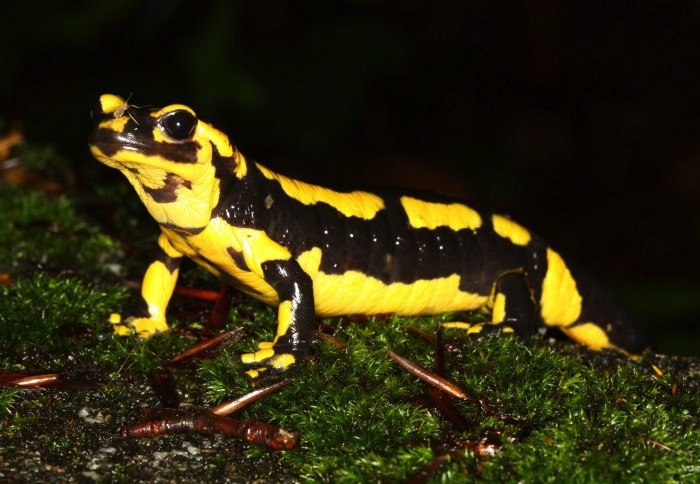Odd Cause of Salamander Die-Off Found: Skin-Eating Fungus

A newly discovered fungus that feasts on the skin of amphibians is threatening to decimate a species of salamander in the Netherlands, according to new research.
Fire salamanders are one of the most recognizable salamander species in Europe, and are characterized by their distinct yellow- and black-patterned skin. Since 2010, fire salamanders have been mysteriously dying off in the forests of the Netherlands.
Now, scientists have identified a deadly fungus, called Batrachochytrium salamandrivorans (the second part of the name translates to "salamander-eating"), that they say is jeopardizing biodiversity and bringing fire salamanders close to the brink of regional extinction. [Photos: Bizarre Frogs, Lizards and Salamanders]
Previously, a fungus species related to the salamander-eating variety was the culprit behind mass amphibian casualties around the globe. That fungus, named Batrachochytrium dendrobatidis, or Bd, is thought to have devastated more than 200 amphibian species worldwide, the researchers said. The fungus Bd also causes the disease chytridiomycosis, which has been labeled the most devastating infectious disease in vertebrate animals by the International Union for the Conservation of Nature.
The detection of a new fungus that rapidly kills fire salamanders is an alarming development, said An Martel, a professor in the department of pathology, bacteriology and poultry diseases at the Ghent University in Belgium, and lead author of the new study.
"In several regions, including northern Europe, amphibians appeared to be able to co-exist with Bd," Martel said in a statement. "It is, therefore, extremely worrying that a new fungus has emerged that causes mass mortalities in regions where amphibian populations were previously healthy."
The fungus can be spread between salamanders through direct contact, and although the researchers suspect it can also spread through indirect contact, they have yet to prove this type of transmission. The fungus typically invades the salamander's skin, quickly killing the animal, the scientists said.
Sign up for the Live Science daily newsletter now
Get the world’s most fascinating discoveries delivered straight to your inbox.
Still, much is unknown about the newly identified fungus. Tests to infect midwife toads, which have been threatened by chytridiomycosis, have shown that these toads are not susceptible to the salamander-eating fungus. Nonetheless, the vulnerability of other species of amphibians to the disease is not yet known.
"It is a complete mystery why we are seeing this outbreak now, and one explanation is that the new salamander-killing fungus has invaded the Netherlands from elsewhere in the world," study co-author Matthew Fisher, a professor of fungal disease epidemiology at Imperial College London, said in a statement. "We need to know if this is the case, why it is so virulent, and what its impact on amphibian communities will be on a local and global scale."
By figuring out which species are at risk, scientists may be able to take steps to protect vulnerable populations in the wild, he added.
"Our experience with Bd has shown that fungal diseases can spread between amphibian populations across the world very quickly," Fisher said. "We need to act urgently to determine what populations are in danger and how best to protect them."
To save the fire-salamander population in the Netherlands, the researchers brought survivors into captivity. The scientists have also developed a diagnostic tool to quickly identify the fungus, which they used to test 100 salamanders from Belgium. So far, there are no indications that the deadly fungus has spread outside the Netherlands, the researchers said.
The study findings were detailed Sept. 2 in the journal Proceedings of the National Academy of Sciences.
Follow Denise Chow on Twitter @denisechow. Follow LiveScience @livescience, Facebook & Google+. Original article on LiveScience.

Denise Chow was the assistant managing editor at Live Science before moving to NBC News as a science reporter, where she focuses on general science and climate change. Before joining the Live Science team in 2013, she spent two years as a staff writer for Space.com, writing about rocket launches and covering NASA's final three space shuttle missions. A Canadian transplant, Denise has a bachelor's degree from the University of Toronto, and a master's degree in journalism from New York University.
Stabbed, cut, attacked, twisted — scientists subject new stretchable battery to extreme torture, and it retained 90% of its capacity
How accurate are smart rings, and how do they compare to fitness watches?
Plains viscacha: A rodent that builds vast underground cities and ovulates more than any other mammal









